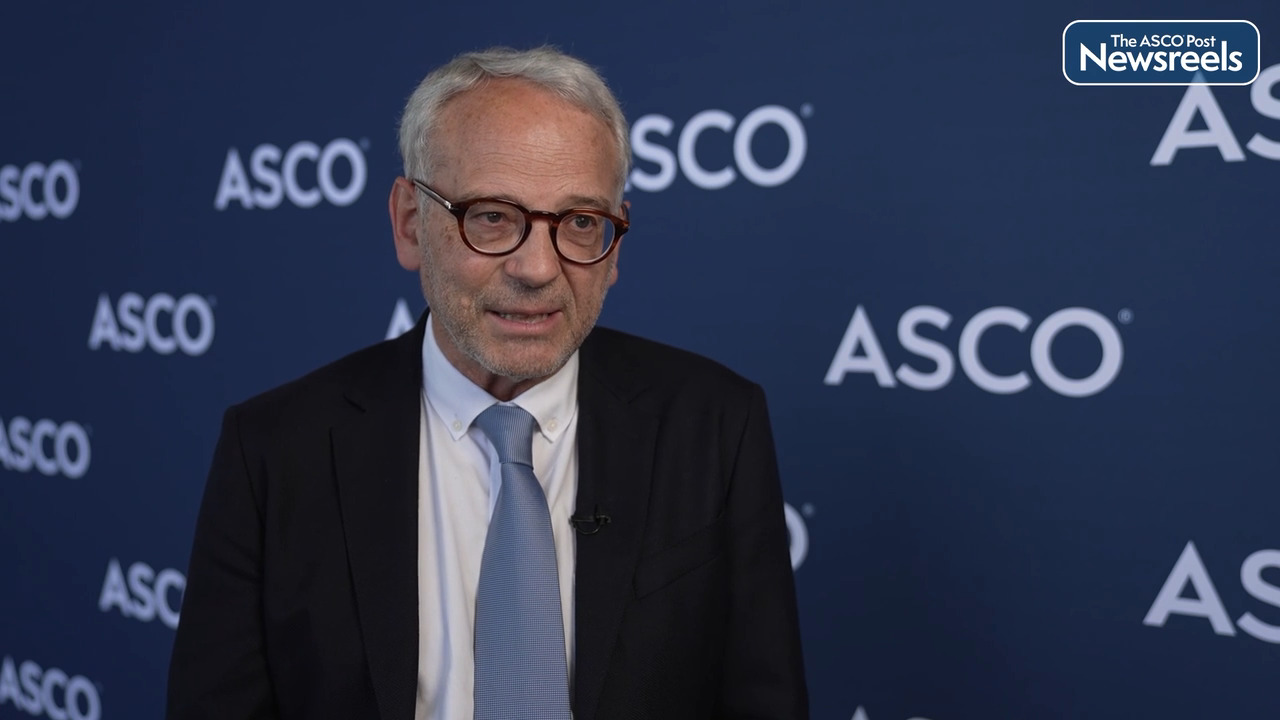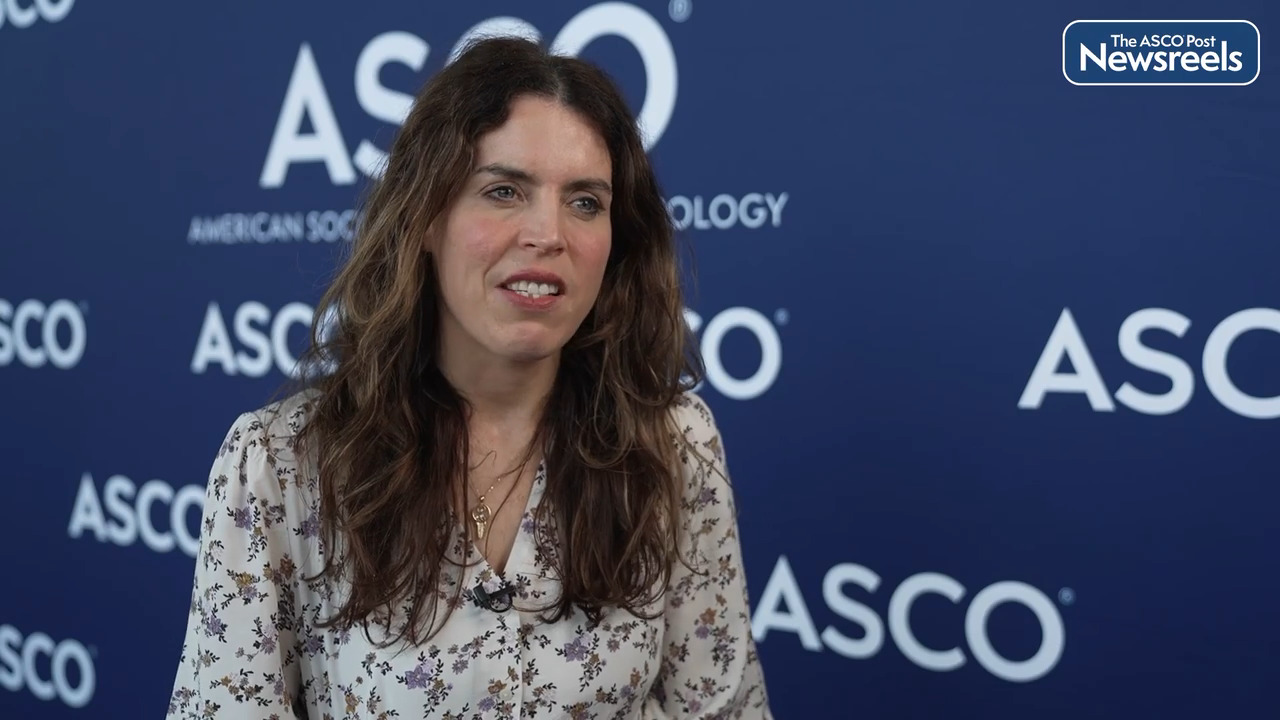James Chih-Hsin Yang, MD, PhD, on Metastatic Nonsquamous NSCLC: Evaluating Pemetrexed and Platinum With or Without Pembrolizumab
2023 ASCO Annual Meeting
James Chih-Hsin Yang, MD, PhD, of the National Taiwan University Hospital and National Taiwan University Cancer Center, discusses the latest data from the phase III KEYNOTE-789 study, which evaluated the efficacy and safety of pemetrexed plus platinum chemotherapy (carboplatin or cisplatin) with or without pembrolizumab in the treatment of adults with EGFR tyrosine kinase inhibitor–resistant, EGFR–mutated, metastatic nonsquamous non–small cell lung cancer (NSCLC) (Abstract LBA9000).
Transcript
Disclaimer: This video transcript has not been proofread or edited and may contain errors.
James Chih-Hsin Yang:
Patients who had EGFR mutation, stage four non-small cell lung cancer, the standard of care is tyrosine kinase inhibitors as a first line. When they fail, they have to receive chemotherapy as a standard of care. KEYNOTE-789 is a randomized phase three study, testing whether adding pembrolizumab to the standard chemotherapy is going to help overall survival and progression-free survival.
492 patients who are randomized into two arms. One, pembrolizumab plus end of care chemotherapy versus chemotherapy plus placebo. The co-primary endpoints were progression-free survival and overall survival. There were three interim analysis. Progression-free survival time were done at the interim analysis two.
The hazard ratio was 0.8, which nearly touched the statistical significant P value of boundary 0.0117 and therefore miss the endpoint. The overall survival endpoint was done at the interim analysis three, which was then final analysis 42 months after the last patient's randomized. The overall survival hazard ratio was 0.84, was also statistically not significant.
We also look at the pathological and clinical factors. We try to figure out whether patients with different characteristics can benefit from pembrolizumab adding to chemotherapy. Unfortunately, there was only one factor that seems to help these patients, which is PD-L1 status. Patients who had PD-L1 more than 1%, which is close to 50% of the population, the hazard ratio for overall survival was 0.77. Where those patients who did not have PD-L1 expression, their hazard ratio for overall survival was 0.91. So, we had a study that we cannot change the standard practice, yet the finding that PD-L1 status may help us to choose a patient when asked for future study.
Related Videos
The ASCO Post Staff
Amer Methqal Zeidan, MBBS, MHS, of Yale University and Yale Cancer Center, discusses phase III findings on the first-in-class telomerase inhibitor imetelstat, which was given to patients with heavily transfusion-dependent non-del(5q) lower-risk myelodysplastic syndromes that are resistant to erythropoiesis-stimulating agents. Imetelstat resulted in a significant and sustained red blood cell (RBC) transfusion independence in 40% of these heavily transfused patients. The response was also durable and accompanied by an impressive median hemoglobin rise of 3.6 g/dL, and seen in patients with and without ring sideroblasts. Importantly, reduced variant allele frequency was observed in the most commonly mutated myeloid genes which correlated with duration of transfusion independence and hemoglobin rise, therefore suggesting a disease-modifying potential of this agent (Abstract 7004).
The ASCO Post Staff
Thierry Conroy, MD, of the Institut de Cancérologie de Lorraine, discusses phase III findings from the PRODIGE 23 trial, showing that neoadjuvant chemotherapy with mFOLFIRINOX followed by chemoradiotherapy, surgery, and adjuvant chemotherapy improved all outcomes, including overall survival, in patients with locally advanced rectal cancer compared with standard chemoradiotherapy, surgery, and adjuvant chemotherapy (Abstract LBA3504).
The ASCO Post Staff
Claire Roddie, PhD, MBChB, of University College London, discusses results of the FELIX study, which showed that the second-generation chimeric antigen receptor (CAR) T-cell therapy obecabtagene autoleucel is safe for adults with relapsed or refractory B-cell acute lymphoblastic leukemia, even those with a high burden of disease. This agent yielded high rates of complete response and ongoing CAR T-cell persistence in most patients whose disease responded (Abstract 7000).
The ASCO Post Staff
Reid Merryman, MD, of Dana-Farber Cancer Institute, discusses his findings on the regimen of epcoritamab plus rituximab and lenalidomide for patients with high-risk follicular lymphoma. Regardless of whether their disease progressed within 24 months of first-line chemoimmunotherapy, this regimen showed antitumor activity and a manageable safety profile in patients with relapsed or refractory disease. Epcoritamab, a subcutaneous T-cell–engaging bispecific antibody, may abrogate the negative effects of high-risk features (Abstract 7506).
The ASCO Post Staff
Allison Betof Warner, MD, PhD, of Stanford University Medical Center, and Adnan Khattak, MBBS, FRACP, PhD, of Australia’s Hollywood Private Hospital & Edith Cowan University, discuss the use of the mRNA-4157 vaccine in combination with pembrolizumab as adjuvant therapy for resected high-risk melanoma, which prolonged distant metastasis–free survival compared with pembrolizumab alone. These results provide further evidence that a personalized neoantigen approach is potentially beneficial (Abstract LBA9503).





